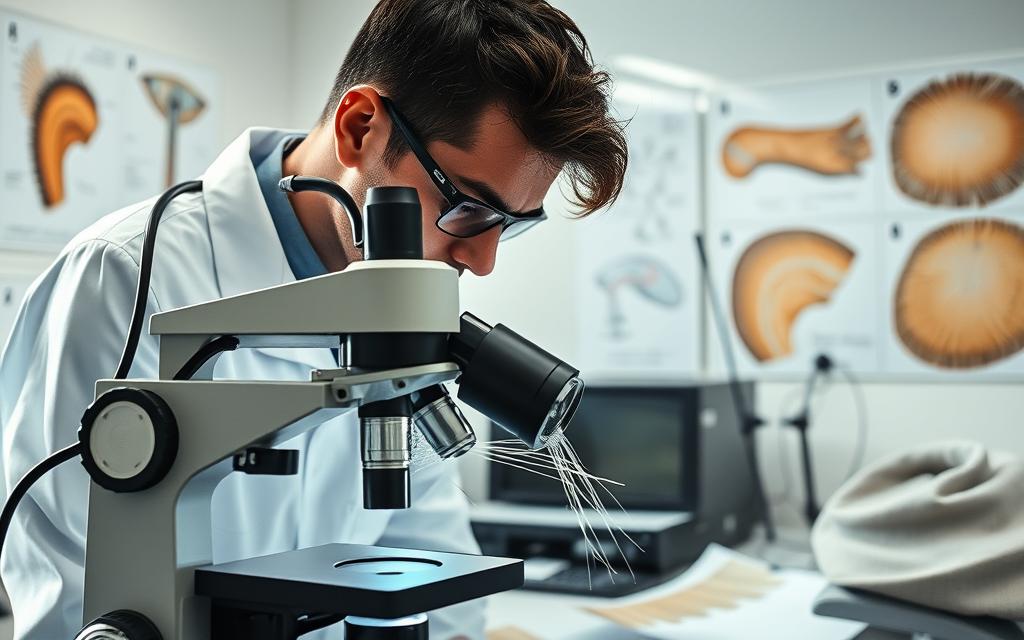Become a Trichologist: Your Guide to Hair Science
Are you interested in hair and scalp health? A career in trichology could be perfect for you. Trichology is the study of hair and scalp, combining dermatology, cosmetology, and medical science. As a trichologist, you’ll explore hair structure, function, and disorders. You’ll help people with different hair and scalp issues.
The field of trichology is expanding in beauty and health fields. You’ll find jobs in clinical settings, product development, and research. If you’re curious about becoming a trichologist, you’re in the right spot. This guide will show you the steps to become a trichologist and why a hair science degree is a good choice.
Trichologists make about $26.34 an hour or $54,787 a year, with top pay in states like New York, California, and Texas1. Starting your trichology career can take from 6 months to 2 years, costing between £3,000 to £10,000+2. While cosmetologists take 2-3 years to train, clinical trichology programs last 2-3 years3.
On this exciting career path, you’ll learn to diagnose and treat hair loss, scalp psoriasis, and more. You’ll understand how genetics, environmental factors, diet, and hormones affect hair and scalp health2. Your skills will be useful in clinics, salons, product labs, and schools.
Key Takeaways
- Trichology combines dermatology, cosmetology, and medical science
- Average trichologist salary is $54,787 per year
- Training programs range from 6 months to 2 years
- Career opportunities include clinical practice, product development, and research
- Trichologists diagnose and treat various hair and scalp conditions
- The field is growing in both beauty and health sectors
- Certifications enhance professional credibility and client trust
Understanding Trichology: The Science of Hair and Scalp
Trichology is a branch of dermatology that focuses on hair and scalp health. It has become more popular as people look for solutions to their hair and scalp problems4. As a specialist, you’ll explore the complex world of hair care and treatment.
Definition and Scope of Trichology
Trichology studies hair and scalp structure, function, and disorders. Unlike dermatologists, trichologists focus only on hair loss, breakage, and scalp issues4. Your training will cover physiology, microbiology, and hair chemistry. This knowledge lets you offer full care for different conditions4.
Importance of Hair and Scalp Health
Hair and scalp health greatly affect self-esteem and life quality5. As a trichologist, you’ll see that scalp health is key to hair growth4. You’ll go beyond just looking good, tackling the root causes of hair and scalp problems for tailored treatments5.
The Role of a Trichologist in Healthcare
Trichologists are key in healthcare, diagnosing and treating issues like genetic hair loss, thinning, dandruff, psoriasis, and dermatitis4. Your approach will be holistic, suggesting lifestyle changes and nutritional tweaks along with treatments4.
| Trichologist’s Responsibilities | Methods Used |
|---|---|
| Diagnose hair and scalp conditions | Scalp analysis, hair sampling |
| Develop treatment plans | Topical treatments, nutritional advice |
| Provide preventive care | Lifestyle recommendations, hair care tips |
Your training in trichology will teach you advanced treatments like laser therapy. This method helps stimulate hair follicles for growth and strengthens hair4. Joining this field means you’ll work with a global team dedicated to bettering hair and scalp health worldwide.
The Fascinating World of Hair Types and Textures
Hair comes in many types and textures, each with its own needs. Knowing your hair type is key to keeping it healthy. It helps with hair loss treatment and scalp disorders.
Fine, Medium, and Coarse Hair Classifications
Hair is divided into three types: fine, medium, and coarse. Fine hair is thin and needs products to add volume. Medium hair is balanced in thickness. Coarse hair is thick and needs extra moisture.
On average, people have 90,000 to 140,000 scalp hair follicles. This number varies with hair color and ethnicity6.
Natural Coiled Curls and Their Unique Needs
Curly and coily hair needs special care. These hair types are drier and more prone to breakage. Using nourishing, sulfate-free shampoos and deep conditioning helps keep curls healthy and prevents damage7.
Tailoring Hair Care to Different Textures
Customizing your hair care is key for good hair health. For oily scalps, use balancing shampoos. Dry hair does well with hydrating formulas. Curly or processed hair needs extra nourishment and repair products.
Regular scalp massages can help hair grow. Using the right tools, like brushes with rounded plastic bristles, prevents damage and boosts blood flow. Understanding your hair type and using the right care can keep your hair healthy. This can also prevent hair loss treatment or scalp disorders7.
Hair Growth Cycle: From Anagen to Exogen
Starting your journey to a trichology certification or hair science degree means learning about the hair growth cycle. This process has four stages, each important for hair health and growth.
The anagen phase is when hair grows actively. Hair can grow about half an inch each month, reaching up to 6 inches in a year8. This stage can last 3-5 years, but up to 7 years for those of Asian descent, allowing hair to grow very long8.
Then, the hair enters the catagen phase, a short transition stage. It lasts about 10 days and affects only 3% of your hair at a time8.
Next, the telogen phase, or resting stage, begins. Here, 10-15% of your hair rests, lasting about 3 months8. New hair starts forming in the follicle, ready to replace the old hair.
The final stage is exogen, where old hairs are shed for new growth. Losing 80-100 hairs daily is normal during this phase8.
| Hair Type | Average Hair Count | Growth Rate |
|---|---|---|
| Caucasian (Blonde) | 146,000 | 1 – 1.25 cm per 28 days |
| Afro-Caribbean | 50,000 – 110,000 | Half of Caucasian rate |
| Asian | 80,000 – 140,000 | Exceeds Caucasian average |
Knowing these phases helps in diagnosing and treating hair problems. Stress, diet, and health issues can affect the cycle, leading to hair loss or thinning8. With a trichology certification or hair science degree, you’ll learn how these factors impact hair growth and develop solutions for different hair issues.
Common Hair and Scalp Disorders Trichologists Treat
Trichologists deal with many hair and scalp problems. They are key in managing alopecia and treating scalp disorders. Let’s look at the common issues they handle and how they treat them.
Hair Loss and Alopecia
Hair loss is a problem for both men and women. For men, pattern baldness can warn of serious health issues like heart disease and diabetes. Women with hair loss might be at higher risk of polycystic ovary syndrome9.
Trichologists check the scalp, ask about health history, and might ask for blood tests. This helps them figure out the cause and the best treatment9.
Scalp Conditions: Psoriasis, Dermatitis, and More
Scalp issues like psoriasis and dermatitis need special care. Trichologists use a microscope to diagnose these conditions. They might suggest treatments or changes in lifestyle to help manage symptoms and keep the scalp healthy9.
Texture Changes and Their Underlying Causes
Hair texture can change due to hormones, the environment, or chemical treatments. Trichologists look into these changes and find out why they happen. They might give advice on nutrition or special hair care routines to fix texture problems9.
| Condition | Possible Causes | Trichologist Approach |
|---|---|---|
| Pattern Baldness | Genetics, Hormones | Scalp examination, Medical history review |
| Telogen Effluvium | Stress, Surgery, Hormonal changes | Lifestyle assessment, Nutrition advice |
| Scarring Alopecia | Inflammatory disorders, Chemical exposure | Microscopic analysis, Referral to specialists |
Trichologists are experts in managing these conditions. Their training, which lasts from 6 months to a year, prepares them to give full care for different hair and scalp problems9. With 90% of hairstylists seeing the value of trichology for their business, it’s clear this field is growing in the beauty world10.
The Science Behind Hair Structure and Health
Hair is made of keratin, a strong protein. It has three main layers: the cuticle, cortex, and medulla. Knowing about these layers is key for hair science and trichology training.
The cuticle is the outer layer, protecting the inside. The cortex is in the middle and gives hair its strength and color. The medulla is at the core but not in all hair types. Trichologists study these to help keep hair healthy11.
Many things affect your hair’s health. Eating right, hormonal balance, and scalp health are important. Pollution, sun damage, and chemical treatments can also harm your hair. Knowing about these is crucial in trichology training.
Trichologists use special tools to check hair and scalp health. They use microscopes, trichoscopy tools, and scalp analyzers. These help diagnose problems like hair loss or scalp infections12.
Advanced treatments include PRP therapy and stem cell Conditioned Media (AAPE). These treatments help hair grow by using the body’s own healing powers13.
Studying hair science teaches you how to fix different hair problems. You’ll learn to help with dandruff and even alopecia areata. This makes you very helpful in keeping hair and scalps healthy11.
How to Become a Trichologist: Education and Training
Starting a career as a trichologist takes you into the exciting world of hair and scalp health. It’s a field that needs commitment, learning, and ongoing education. Let’s look at the steps to become a trichologist and the certification process.
Required Educational Background
To begin, you need a strong educational base. A high school diploma or GED is the basic requirement. Some people might choose to get an associate’s degree in cosmetology or a similar field for a deeper understanding of hair care. If you have a medical background, you might need more education1.
Accredited Trichology Programs
Trichology certification programs come in different lengths and levels of detail. Some can be finished in just 6 months, while others might take 2-3 years1. The International Association of Trichologists (IAT) has a course with 190 lessons, created at the University of Southern California14.
Certification Process and Continuing Education
To get certified, you’ll need to do coursework, practical training, and pass exams. The cost of getting certified can change. For example, IAT’s course costs $2,520 if you pay all at once, with extra fees for clinical training14. Another program has three certification stages, with prices from $1,250 to $1,500 per stage15.
Staying current with new research and techniques is key in this field. Trichologists must keep learning to give their clients the best care. With hard work and the right training, a career in trichology can be fulfilling and profitable, with some specialists making up to $90,000 a year15.
| Certification Stage | Focus | Cost |
|---|---|---|
| Stage 1 | Desquamation | $1,250 |
| Stage 2 | Hair Growth | $1,500 |
| Stage 3 | Advanced Training | $1,500 |
Essential Skills and Qualities for Aspiring Trichologists
Starting a career in trichology means blending science knowledge with people skills. You’ll need a solid base in biology, chemistry, and anatomy. This field has been around since 190216.
You must have sharp analytical skills for looking at hair samples and understanding data. Paying close attention to details is key when figuring out hair loss causes like hormonal issues, diet problems, or genetics17.

Being empathetic and good at explaining things is crucial. Clients often feel stressed about their hair or scalp problems. You need to explain complex ideas simply and show care.
Keeping up with new research and treatments is a must. Trichology is always changing, with new discoveries all the time. Staying updated will help you offer better treatments18.
| Key Skills | Why It’s Important |
|---|---|
| Scientific Knowledge | Accurate diagnosis and treatment |
| Analytical Thinking | Interpret test results and research |
| Empathy | Build trust with clients |
| Communication | Explain conditions and treatments clearly |
| Continuous Learning | Stay updated with latest advancements |
Working on these skills will help you make a big difference in trichology. You could earn an extra $118,368 a year after getting certified18.
Career Opportunities in Trichology
Trichology offers many career paths for those interested in hair science and scalp health. As a trichologist, you’ll find work in clinics, research, and education.
Clinical Practice and Consultancy
You’ll work with clients who have hair loss and scalp problems in clinical settings. Trichologists team up with dermatologists and oncologists to create treatment plans19. You might use treatments like steroid shots, topical sensitizers, or low-level laser therapy for hair loss19.
Research and Product Development
Many trichologists work in research, helping advance hair science. Hair care companies hire trichologists to ensure their products are top-notch20. Your knowledge can lead to new solutions for hair and scalp issues.
Education and Training Roles
You can make a difference in education as a trichologist. The World Trichology Society, started by Dr. David H. Kingsley, aims to improve trichology education in North America19. You could teach in trichology programs or run workshops for new professionals.
The career path of a trichologist is varied and fulfilling. About 75% of them have a bachelor’s degree in fields like biology or chemistry21. Training takes 6-12 months, covering hair and scalp anatomy, physiology, and pathology21. With time, you could start your own practice or work in forensic departments, using your skills in new ways20.
As more people learn about hair and scalp health, the need for trained trichologists grows20. This field offers great opportunities for those who love hair science and want to help others have healthy hair and scalps.
The Trichologist’s Toolkit: Diagnostic Methods and Equipment
As a hair and scalp specialist, you’ll use many tools to diagnose and treat hair disorders. Your trichology training teaches you how to use these important tools well.
Trichoscopes are key for looking closely at the scalp. They let you see hair follicles and scalp conditions clearly. Hair analysis microscopes let you study hair structure and find potential problems. Scalp cameras give you clear images for detailed checks and tracking progress22.
Blood tests are also important in your toolkit. They show nutritional shortages or hormonal imbalances that might cause hair loss or scalp issues. These tests help you make specific treatment plans for your patients23.
| Diagnostic Tool | Purpose | Benefits |
|---|---|---|
| Trichoscope | Detailed scalp examination | Identifies follicle issues, scalp conditions |
| Hair analysis microscope | Study hair structure | Detects abnormalities in hair shafts |
| Scalp camera | High-resolution imaging | Tracks progress, provides visual evidence |
| Blood tests | Identify underlying issues | Reveals nutritional deficiencies, hormonal imbalances |
Your trichology training also teaches you how to assess hair density, growth patterns, and scalp conditions. These methods help you make accurate diagnoses and plan effective treatments for different hair and scalp problems24.
By getting good at these diagnostic tools and methods, you can handle a lot of hair and scalp issues. This includes common problems like dandruff and more complex ones like alopecia areata22.
Trichology vs. Dermatology: Understanding the Differences
Trichology and dermatology are both fields that focus on hair and scalp health. But they have different areas of focus and methods.
Scope of Practice
Trichologists focus only on hair and scalp health. They spend a lot of time with patients, often an hour or more at first, for a detailed look and tailored treatment plans25. Dermatologists, though, deal with many skin issues, including hair, but usually don’t spend as much time with each patient because they have more to cover25.
Educational Requirements
Getting to be a trichologist is different from becoming a dermatologist. Dermatologists go through a lot of medical training. Trichology programs, on the other hand, are for those with a healthcare background. They focus on special skills like trichoscopy, mesotherapy, and PRP therapy26.
| Aspect | Trichology | Dermatology |
|---|---|---|
| Focus | Hair and scalp health | Skin, hair, and nail conditions |
| Consultation Time | 1 hour or more | About 5 minutes |
| Treatment Approach | Holistic, including nutrition and scalp therapies | Medical therapies, skin cancer treatments |
Collaborative Opportunities
Trichologists and dermatologists are working together more often, giving patients full care for hair and scalp problems25. This teamwork brings together trichology’s deep knowledge with dermatology’s wide expertise. This means better treatment options for those facing hair loss or scalp issues.
Knowing these differences helps you make a better choice when looking for help with hair and scalp issues. Whether you go to a trichologist or a dermatologist, both can offer great advice for keeping your hair and scalp healthy.
Building a Successful Trichology Practice
Starting a career in trichology requires hard work and careful planning. The International Trichology Society (ITS) offers courses that teach important subjects like human biology and hair loss conditions27. These programs let you learn by doing and connect with experts, getting you ready for real-world challenges27.
To begin, get the right licenses and make a strong business plan. The International Association of Trichologists (IAT) has a detailed course with 190 lessons for USD $2520 if you pay all at once14. This education is key to learning about hair loss and scalp health.
Find a good spot for your clinic and buy the needed tools. Work with other health professionals for more clients. Offer both in-person and online consultations to reach more people. Keep up with new treatments to give your clients the best care.
| Aspect | Details |
|---|---|
| Course Duration | 190 lessons |
| Course Fee | USD $2520 (full payment) |
| Clinical Placement | USD $2000 (additional) |
| IAT Experience | 52 years of training |
| Course Modules | 13 (covering various topics) |
The IAT course, made at the University of Southern California, has been updated since 1974-7514. It includes 13 modules on trichology, body systems, and more14. This wide-ranging education will help you succeed in your trichology career.
Staying Current: The Importance of Ongoing Research in Trichology
In the fast-changing world of trichology, keeping up is key for professionals. Your training and degree are just the start of a journey of learning that never stops.
Emerging Treatments and Technologies
Hair science is always moving forward. Trichologists now use tools like Trichoscopy and HairCheck for better hair loss diagnosis and treatment28. These tools help make hair care plans that fit each patient’s unique needs.
Attending Conferences and Workshops
Conferences are important for growing your skills. The International Trichology Society (ITS) conference in London on August 15-16, 2023, is a great place to learn and work together29. You’ll meet top experts, join in workshops, and learn new skills to use in your work.
Contributing to the Field Through Publications
Sharing what you know helps move trichology forward. Think about writing for academic or industry journals. The International Association of Trichologists (IAT) has been training trichologists for over 50 years and offers great resources for staying informed and sharing your work30.
| Activity | Benefits |
|---|---|
| Attending conferences | Networking, learning from experts, exposure to new technologies |
| Publishing research | Contributing to the field, establishing expertise, professional growth |
| Continuous education | Staying updated on treatments, improving patient care, career advancement |
By taking part in ongoing research and learning, you’ll get better at what you do and be known as an expert in trichology. This dedication to learning helps you and your patients by offering the latest and best in hair and scalp care.
The Future of Trichology: Trends and Innovations
The world of trichology is changing fast, offering new hope for those facing hair loss and scalp issues. Hair thinning and baldness are becoming more common, making new treatments vital31. Trichologists are now working on advanced solutions due to stress and pollution causing hair loss31.
Stem cell therapies are leading the way in hair loss research32. Exosomes are showing great promise in healing wounds, stopping alopecia, and making skin look younger, based on early studies32. Growth factors are being studied for their ability to help hair grow back and treat hair loss32.
Trichology training is getting more advanced, covering techniques like PRP therapy, folliculoscopy, trichoscopy, and laser tech31. This deeper training helps professionals handle a variety of hair problems better31.
Emerging Treatments and Holistic Approaches
Personalized care is the future of treating hair loss. Trichologists now see stress and non-hormonal factors as big causes of hair loss32. Eating gluten-free and cutting down on sugar can help prevent hair loss after COVID-1932.
Scalp treatments now include antioxidants like vitamins C and E to fight stress that harms hair follicles32. Minerals like zinc, iron, and selenium are key for a healthy scalp and hair32.
| Innovative Treatment | Benefits |
|---|---|
| Stem cell therapy | Promotes hair follicle regeneration |
| Exosome treatment | Enhances wound healing and combats alopecia |
| Growth factor therapy | Stimulates hair regrowth |
| Antioxidant scalp treatments | Protects against follicle damage |
As trichology moves forward, it’s not just about treating hair and scalp issues. It’s also about supporting patients emotionally32. This approach helps patients deal with the emotional side of hair loss, making trichology a fulfilling career for those who care about helping others32.
Conclusion
Starting a career in trichology combines science and beauty. You’ll explore the exciting world of hair and scalp health. You’ll help with issues like hair loss and scalp problems3334.
To become a trichologist, first get a strong base in cosmetology or barbering. Then, take specialized training from approved programs. The American Academy of Hair and Scalp Diseases has a Certified Trichologist program for licensed pros. This could increase your yearly income by $118,36833.
As a trichologist, you’ll connect dermatology and cosmetology. You’ll do scalp and health checks, and nutritional assessments. Even though you can’t diagnose or prescribe, you’ll work with doctors and other experts for full care. This team includes dermatologists, hair stylists, and mental health professionals3334.
With more people needing hair loss solutions, your skills will be in high demand. By keeping up with new treatments and tech, you’ll become a top expert in this field. You can work in clinics, research, or teaching. A career in trichology offers both personal satisfaction and professional growth.
FAQ
What is trichology?
Trichology is the study of hair and scalp health. It looks at the structure, function, and disorders of hair and scalp. It combines dermatology, cosmetology, and medical science.
Why is understanding hair types and textures important for trichologists?
Knowing about hair types (fine, medium, and coarse) and textures (straight, wavy, curly, or coily) helps trichologists. It helps them diagnose hair and scalp problems. They can then suggest the right care routines and treatments.
What are the stages of the hair growth cycle?
The hair growth cycle has four stages: Anagen (active growth), Catagen (transition), Telogen (resting), and Exogen (shedding). Knowing these stages is key for diagnosing and treating hair loss and scalp conditions.
What are some common hair and scalp disorders trichologists treat?
Trichologists treat many conditions. These include hair loss and alopecia, scalp issues like psoriasis and dermatitis, and changes in texture due to hormones, the environment, or chemicals.
What educational background is required to become a trichologist?
To be a trichologist, start with a high school diploma or GED. Then, get an associate’s degree in cosmetology or a similar field. Finally, complete a trichology program, which takes 6 months to 2 years.
What are the essential skills and qualities for aspiring trichologists?
Good trichologists need scientific knowledge, attention to detail, empathy, and strong communication skills. They should know biology, chemistry, and anatomy well. They must be okay with using microscopes and understanding scientific data.
What career opportunities are available in trichology?
Trichology offers many career paths. You can work in clinical practice, research, product development, education, or consultancy. Jobs are available in hair restoration clinics, dermatology offices, salons, spas, and hair care brands.
What diagnostic methods and equipment do trichologists use?
Trichologists use trichoscopes, hair analysis microscopes, scalp cameras, and standard assessment methods. They might also order blood tests to check for nutritional or hormonal issues.
What’s the difference between trichology and dermatology?
Trichology focuses on hair and scalp health. Dermatology deals with all skin issues. Trichologists get specialized certification, while dermatologists are medical doctors. They often work together for full care.
What should be considered when starting a trichology practice?
Starting a trichology practice means getting the right licenses and certifications. You need a business plan, funding, and essential equipment. Building a network with healthcare professionals and marketing well is also key.
Source Links
- https://cosmetologyguru.com/blog/how-to-become-a-trichologist/ – How to Become a Trichologist – A Comprehensive Guide
- https://londonspd.com/blog/pursue-a-career-how-to-become-a-trichologist/ – Pursue a Career: How to Become a Trichologist
- https://www.wikihow.com/Become-a-Trichologist – Simple Ways to Become a Trichologist: 15 Steps (with Pictures)
- https://hairlossclinic.ca/introduction-to-trichology-and-role-of-a-trichologist/ – Introduction to Trichology and Role of a Trichologist
- https://www.gthairboutique.com/post/trichology-101-understanding-the-science-of-hair-and-scalp-health – Trichology 101: Understanding the Science of Hair and Scalp Health
- https://drrajivdesaimd.com/2014/04/09/hair/ – HAIR – Dr Rajiv Desai
- https://www.nytimes.com/article/hair-wash-routine-shampoo-conditioner-tips.html – How to Wash Your Hair
- https://www.philipkingsley.co.uk/hair-guide/hair-science/hair-growth-cycle.html – The Hair Growth Cycle
- https://www.webmd.com/a-to-z-guides/what-is-a-trichologist – What Is a Trichologist?
- https://aahsd.com/ – American Academy of Hair and Scalp Diseases | AAHSD
- https://beckyb.com.au/blog/what-is-a-trichologist/ – What is a Trichologist and Do I Need One?
- https://www.ink2scalp.com/post/trichologist-vs-scalp-micropigmentation – Qualifications for Hair Professionals -Trichologist Vs Scalp Micropigmentation Artist
- https://hairlossclinic.ca/an-in-depth-examination-of-trichology-a-comprehensive-field-in-hair-and-scalp-care/ – An In-depth Examination of Trichology: A Comprehensive Field in Hair &Scalp Care
- https://www.iattrichology.com/trichology-course/ – Trichology Course – International Association of Trichologists
- https://trichologiste.com/ – Online Trichology Certification in Montreal | Clinique Capillaire
- https://trichologiste.com/from-hairdresser-to-trichologist-maximize-your-income-potential-with-certification/ – Become a Trichologist and Maximize Your Income | Clinique Capillaire Carole Raby
- https://londonspd.com/blog/what-is-a-trichologist-unveiling-the-profession/ – What is a Trichologist? Unveiling the Profession
- https://primehealers.com/unlock-the-secrets-of-trichology-with-professional-courses/?srsltid=AfmBOooNCGITwVDamhTo6FVXWJojq9oVbpwefi_GwBgU_5G9Q_lOltK8 – Unlock the Secrets of Trichology With Professional Courses
- https://www.beautyschoolsdirectory.com/programs/hair-design/trichology – Trichology
- https://www.iicsam.com/how-to-make-a-successful-career-in-trichology/ – How to Make a Successful Career in Trichology | IICSAM
- https://www.careerexplorer.com/careers/hair-loss-specialist/how-to-become/ – How to become a trichologist
- https://hairrestorationtour.com/what-is-a-trichologist/ – What is a Trichologist? | Why would you go to a trichologist?
- https://www.careerexplorer.com/careers/trichologist/ – What does a trichologist do?
- https://drpaulsinstitute.in/the-comprehensive-approach-of-medical-trichology-courses/ – The Comprehensive Approach of Medical Trichology Courses – Dr Paul Institute
- https://www.trichology.com/trichology-vs-dermatology/ – Trichology VS Dermatology | Trichology
- https://www.iicsam.com/how-dermatology-trichology-training-different/ – How is Dermatology and Trichology Training Different?
- https://internationaltrichologysociety.com/become-a-trichologist/ – Become a Trichologist – International Trichology Society
- https://hairlossclinic.ca/trichologist-toronto-professional-care-for-hair-and-scalp-health/ – Trichologist Toronto: Professional Care for Hair and Scalp Health
- https://internationaltrichologysociety.com/trichology/trichology-conferences/ – Trichology Conferences – International Trichology Society
- https://www.amevitality.com/education/navigating-the-path-to-becoming-a-trichologist-a-personal-journey-and-professional-perspective – Navigating the Path to Becoming a Trichologist: A Personal Journey and Professional Perspective — âme vitality
- https://drpaulsinstitute.in/how-effective-is-trichology-training-to-treat-hair-conditions/ – How Effective Is Trichology Training to Treat Hair Conditions? – Dr Paul Institute
- https://www.svensonhair.com.sg/articles/world-trichology-conference-2023 – World Trichology Conference 2023 | Svenson Hair Centres
- https://healthcareguys.com/2022/09/23/who-are-trichologists-and-how-to-become-one/ – Who are Trichologists and how to become one – The Healthcare Guys
- https://fortesclinic.co.uk/blog/what-is-a-trichologist/ – What Is A Trichologist? | Fortes Clinic







